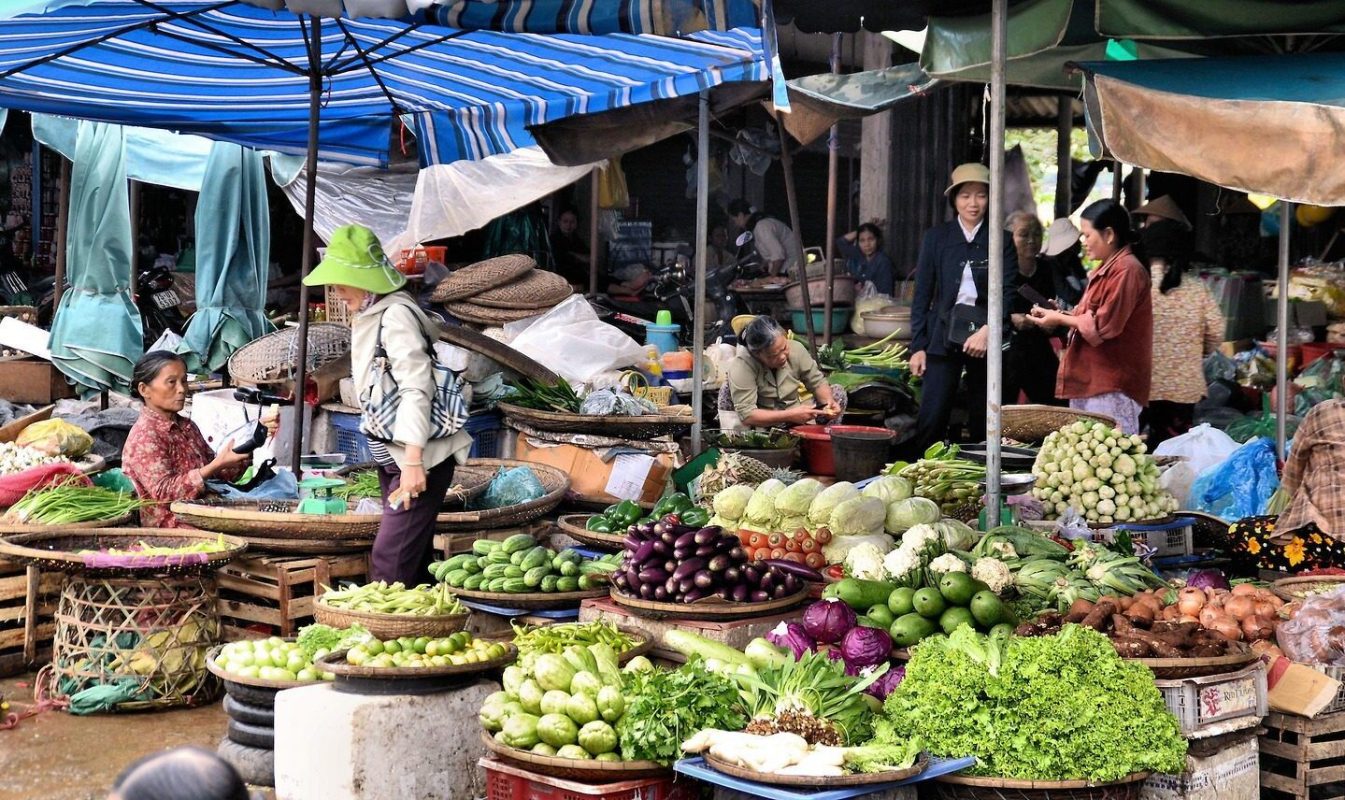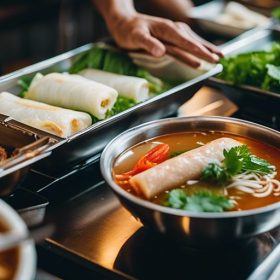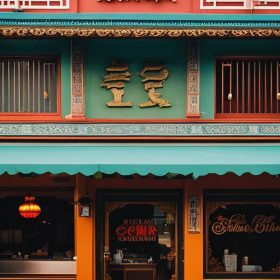Vietnamese cuisine is known for its vibrant flavors, fresh ingredients, and diverse culinary traditions. With a history that dates back thousands of years, Vietnamese food has been shaped by various influences, including Chinese, French, and Southeast Asian cuisines. Food holds a special place in Vietnamese culture, with meals often being a time for family and friends to come together and share in the joy of eating. In this article, we will explore the rich culinary history and traditions of Vietnam, as well as some of the iconic dishes that have made Vietnamese cuisine so beloved around the world.
The Role of Street Food in Vietnamese Cuisine
Street food culture is an integral part of Vietnamese cuisine. In Vietnam, the streets are filled with vendors selling a wide variety of delicious and affordable dishes. From steaming bowls of pho to crispy banh mi sandwiches, street food offers a taste of authentic Vietnamese flavors. Some popular street food dishes include banh xeo (Vietnamese savory pancakes), bun bo Hue (spicy beef noodle soup), and com tam (broken rice with grilled pork). These dishes are often made with fresh ingredients and cooked right in front of you, ensuring that you get a truly authentic experience.
One of the reasons why street food is so important in Vietnamese cuisine is because it reflects the country’s history and culture. Many street food dishes have been passed down through generations, with each family adding their own unique twist to the recipe. Street food also provides an opportunity for people to try a wide variety of dishes without breaking the bank. In Vietnam, it is common for people to eat out multiple times a day, with each meal consisting of a different street food dish. This allows people to explore the diverse flavors of Vietnamese cuisine and discover new dishes that they may not have tried otherwise.
The Iconic Dish of Pho: History, Ingredients, and Variations
Pho is perhaps one of the most well-known Vietnamese dishes, and it has gained popularity around the world. This iconic noodle soup is believed to have originated in the early 20th century in northern Vietnam. It is made with a flavorful broth, rice noodles, and various toppings such as beef or chicken. The broth is typically simmered for hours with a combination of spices and herbs, including star anise, cinnamon, and ginger, giving it a rich and aromatic flavor.
Pho comes in many different variations, depending on the region and personal preferences. In the north, pho is often served with thinly sliced beef or chicken, while in the south, it is common to find pho with additional toppings such as beef balls or tripe. Vegetarian versions of pho are also available, with tofu or mushrooms replacing the meat. Each variation has its own unique flavor profile, but they all share the same comforting and satisfying qualities that make pho so beloved.
Bun Cha: The Beloved Grilled Pork Noodle Dish from Hanoi
Bun cha is a popular dish that originated in Hanoi, the capital city of Vietnam. It is made with grilled pork patties, vermicelli noodles, fresh herbs, and a dipping sauce. The pork patties are marinated in a combination of fish sauce, garlic, sugar, and other spices before being grilled to perfection. The noodles are then topped with the grilled pork patties and served with a side of fresh herbs and a tangy dipping sauce.
Bun cha is typically eaten by taking a small portion of noodles and pork patties and dipping them into the sauce before taking a bite. The combination of flavors and textures in bun cha is what makes it so delicious. The smoky and slightly sweet pork patties pair perfectly with the fresh herbs and tangy sauce, creating a harmonious balance of flavors.
Banh Mi: The Delicious and Affordable Vietnamese Sandwich
Banh mi is a Vietnamese sandwich that has gained popularity around the world. It is made with a crusty baguette that is filled with various ingredients such as grilled pork, pate, pickled vegetables, and fresh herbs. The combination of flavors and textures in banh mi is what makes it so unique and delicious.
The history of banh mi can be traced back to the French colonial period in Vietnam. The French introduced baguettes to Vietnam, and the Vietnamese people adapted them to create their own version of a sandwich. Over time, banh mi has evolved to include a wide variety of fillings, including tofu, chicken, and even seafood.
Exploring the Many Flavors of Vietnamese Spring Rolls
Spring rolls are a popular dish in Vietnamese cuisine. They are made by wrapping a variety of ingredients such as shrimp, pork, vegetables, and herbs in rice paper. The rolls are then served with a dipping sauce, typically made with fish sauce, lime juice, sugar, and chili.
The history of spring rolls can be traced back to China, where they were originally made with wheat-based wrappers. When spring rolls were introduced to Vietnam, the Vietnamese people adapted them to use rice paper instead. This change gave the spring rolls a lighter and more delicate texture.
There are many variations of spring rolls in Vietnamese cuisine. Some popular variations include cha gio (fried spring rolls), goi cuon (fresh spring rolls), and nem lui (lemongrass pork skewers wrapped in rice paper). Each variation has its own unique combination of flavors and textures, but they all share the same deliciousness that makes spring rolls so beloved.
The Unique Flavors of Central Vietnamese Cuisine
Central Vietnamese cuisine is known for its bold flavors and unique ingredients. The region is home to dishes such as bun bo Hue (spicy beef noodle soup), mi Quang (turmeric noodles with pork and shrimp), and banh xeo (Vietnamese savory pancakes). These dishes often feature a combination of spicy, sour, and sweet flavors, creating a complex and satisfying taste.
One of the unique ingredients used in central Vietnamese cuisine is shrimp paste. Shrimp paste is made by fermenting shrimp with salt, resulting in a pungent and flavorful condiment. It is often used in dishes such as bun bo Hue and mi Quang to add depth and complexity to the flavors.
Another unique ingredient used in central Vietnamese cuisine is lemongrass. Lemongrass is a fragrant herb that adds a citrusy and refreshing flavor to dishes. It is often used in marinades for grilled meats, as well as in soups and stir-fries.
Seafood Specialties from Vietnam’s Coastal Regions
Vietnam’s long coastline provides an abundance of fresh seafood, which is a staple in coastal Vietnamese cuisine. Some popular seafood dishes include ca kho to (caramelized fish), tom rang muoi (salt and pepper shrimp), and banh canh cua (thick noodle soup with crab).
The flavors of seafood dishes in Vietnam are often enhanced with the use of fish sauce, which is made from fermented fish. Fish sauce adds a savory and umami flavor to dishes, giving them a distinct taste that is unique to Vietnamese cuisine.
Vegetarian and Vegan Options in Vietnamese Cuisine
Vietnamese cuisine offers a wide variety of vegetarian and vegan options. Many traditional Vietnamese dishes can be easily adapted to be vegetarian or vegan by substituting meat or animal products with tofu, mushrooms, or other plant-based ingredients.
Some popular vegetarian and vegan dishes include pho chay (vegetarian pho), com chay (vegetarian rice), and goi cuon chay (vegetarian spring rolls). These dishes are made with fresh vegetables, tofu, and herbs, creating a light and healthy meal that is full of flavor.
The Influence of French Colonialism on Vietnamese Cuisine
French colonialism had a significant impact on Vietnamese cuisine. The French introduced ingredients such as baguettes, pate, and butter to Vietnam, which were then incorporated into traditional Vietnamese dishes. The combination of French and Vietnamese flavors and techniques created a unique fusion cuisine that is still popular today.
Some popular French-inspired dishes in Vietnamese cuisine include banh mi (Vietnamese sandwich), banh mi pate (baguette with pate), and bo luc lac (shaking beef). These dishes combine the best of both worlds, with the rich and creamy flavors of French cuisine complementing the fresh and vibrant flavors of Vietnamese cuisine.
Where to Find the Best Vietnamese Food in Vietnam and Around the World
Vietnamese food can be found all over the world, but for an authentic experience, it is best to visit Vietnam. In Vietnam, you can find delicious street food vendors in every city and town, offering a wide variety of dishes at affordable prices. Some popular destinations for food lovers include Hanoi, Ho Chi Minh City, and Hoi An.
If you are unable to travel to Vietnam, there are still many great Vietnamese restaurants around the world that offer authentic and delicious Vietnamese food. Some popular Vietnamese restaurants include Pho 75 in Philadelphia, The Slanted Door in San Francisco, and Little Saigon in London.
When looking for the best Vietnamese food, it is important to do your research and read reviews from other customers. Look for restaurants that use fresh ingredients and cook their dishes to order. Don’t be afraid to try new dishes and explore the diverse flavors of Vietnamese cuisine.
Vietnamese cuisine is a treasure trove of flavors, textures, and aromas. With its rich culinary history and traditions, Vietnam has created a unique and vibrant food culture that is loved by people all over the world. From the iconic dish of pho to the beloved banh mi sandwich, Vietnamese food offers a wide variety of dishes that are sure to satisfy any palate. So next time you’re looking for something new and exciting to try, why not give Vietnamese cuisine a chance? You won’t be disappointed.

Cuong Nguyen is a talented writer and experienced waitress at Vietnampalace.net, a renowned Vietnamese restaurant that offers an extensive menu of authentic Vietnamese cuisine. With a background in the competition of Vietnamese cuisine, Cuong brings a wealth of knowledge and expertise to the dining experience. From delicious pho dishes to fresh spring rolls, Cuong ensures that every meal is made with the freshest ingredients and authentic flavors.With exceptional service and a friendly atmosphere, Cuong takes pride in providing a memorable dining experience for every customer.
Whether you’re a vegetarian looking for options or a meat lover craving the flavors of traditional Vietnamese dishes, Cuong guarantees a delightful culinary adventure. So, visit Vietnampalace.net and let Cuong guide you through the tantalizing world of Vietnamese cuisine.



